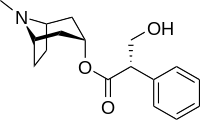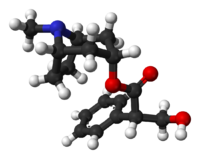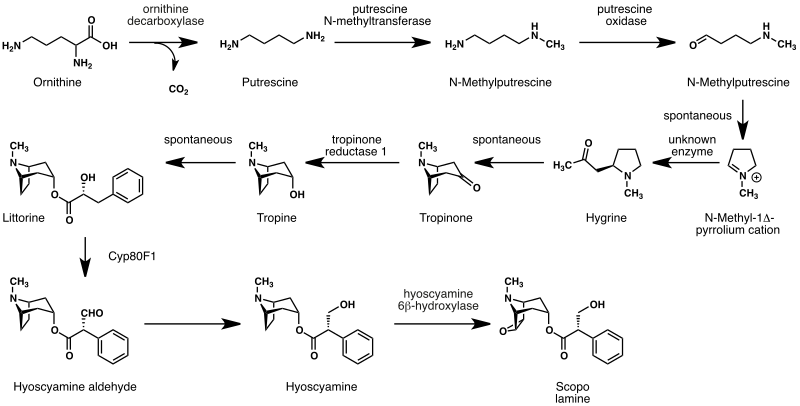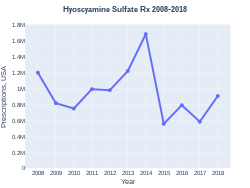Hyoscyamine
 | |
 | |
| Names | |
|---|---|
| Trade names | Anaspaz, Levbid, Levsin, others |
| Other names | Hyoscyamine sulfate, daturine, duboisine |
| |
| Clinical data | |
| Drug class | Antispasmodics (antimuscarinic)[1] |
| Side effects | Dry mouth, urinary retention, blurry vision, palpitations, headache, anxiety, sleepiness, rash, poor coordination[1] |
| Pregnancy category |
|
| Routes of use | By mouth, injection |
| External links | |
| AHFS/Drugs.com | Monograph |
| MedlinePlus | a684010 |
| Legal | |
| Legal status | |
| Pharmacokinetics | |
| Bioavailability | 50% protein binding |
| Metabolism | Hepatic |
| Elimination half-life | 3–5 hrs. |
| Excretion | Urine |
| Chemical and physical data | |
| Formula | C17H23NO3 |
| Molar mass | 289.375 g·mol−1 |
| 3D model (JSmol) | |
| |
| |
Hyoscyamine, sold under the brand name Anaspaz among others, is a medication used to treat irritable bowel syndrome, decrease saliva production, and treat cholinesterase inhibitor toxicity.[1] Evidence for infant colic is poor.[1] It may be taken by mouth or given by injection.[1]
Side effects may include dry mouth, urinary retention, blurry vision, palpitations, headache, anxiety, sleepiness, rash, and poor coordination.[1] Other side effects may include psychosis and glaucoma.[1] It is an antispasmodics or the antimuscarinic type.[1]
Hyoscyamine was initially isolated in 1833 from henbane.[2] It is available as a generic medication under a number of brands.[3] In the United States 30 tablets of 0.125 mg costs less than 10 USD as of 2021.[3]
Medical uses
Hyoscyamine is used to provide symptomatic relief of spasms caused by various lower abdominal and bladder disorders including peptic ulcers, irritable bowel syndrome, diverticulitis, pancreatitis, colic, and interstitial cystitis. It has also been used to relieve some heart problems, control some of the symptoms of Parkinson's disease, as well as for control of abnormal respiratory symptoms and "hyper-mucus secretions" in patients with lung disease.
It is also useful in pain control for neuropathic pain, chronic pain and palliative care – "comfort care" – for those with intractable pain from treatment resistant, untreatable, and incurable diseases. When combined with opioids it increases the level of analgesia (pain relief) obtained. Several mechanisms are thought to contribute to this effect. The closely related drugs atropine and hyoscine and other members of the anticholinergic drug group like cyclobenzaprine, trihexyphenidyl, and orphenadrine are also used for this purpose. When hyoscyamine is used along with opioids or other anti-peristaltic agents, measures to prevent constipation are especially important given the risk of paralytic ileus.
Side effects
Side effects include dry mouth and throat, increased appetite leading to weight gain, eye pain, blurred vision, restlessness, dizziness, arrhythmia, flushing, and faintness. An overdose will cause headache, nausea, vomiting, and central nervous system symptoms including disorientation, hallucinations, euphoria, sexual arousal, short-term memory loss, and possible coma in extreme cases. The euphoric and sexual effects are stronger than those of atropine but weaker than those of Hyoscine, as well as dicycloverine, orphenadrine, cyclobenzaprine, trihexyphenidyl, and ethanolamine antihistamines like phenyltoloxamine.
Pharmacology
Hyoscyamine is an antimuscarinic; i.e., an antagonist of muscarinic acetylcholine receptors. It blocks the action of acetylcholine at parasympathetic sites in sweat glands, salivary glands, stomach secretions, heart muscle, sinoatrial node, smooth muscle in the gastrointestinal tract, and the central nervous system. It increases cardiac output and heart rate, lowers blood pressure and dries secretions.[4] It may antagonize serotonin.[5] At comparable doses, hyoscyamine has 98 per cent of the anticholinergic power of atropine. The other major belladonna-derived drug hyoscine (known in the United States as Scopolamine) has 92 per cent of the antimuscarinic potency of atropine.[5]
Chemistry
It is a naturally occurring tropane alkaloid and plant toxin. It is a secondary metabolite found in certain plants of the family Solanaceae, including henbane (Hyoscyamus niger), mandrake (Mandragora officinarum), angel's trumpets (Brugmansia spp.), jimsonweed (Datura stramonium), tomato (Solanum lycopersicum), the sorcerers' tree (Latua pubiflora), and deadly nightshade (Atropa belladonna). It is the levorotary isomer of atropine (third of the three major nightshade alkaloids) and thus sometimes known as levo-atropine.
Biosynthesis
Hyoscyamine can be extracted from plants of the family Solanaceae, notably Datura stramonium. As hyoscyamine is a direct precursor in the plant biosynthesis of hyoscine, it is produced via the same metabolic pathway.[6]
The biosynthesis of hyoscine begins with the decarboxylation of L-ornithine to putrescine by ornithine decarboxylase (EC 4.1.1.17 Archived 2012-05-09 at the Wayback Machine). Putrescine is methylated to N-methylputrescine by putrescine N-methyltransferase (EC 2.1.1.53 Archived 2012-09-05 at the Wayback Machine).[6]
A putrescine oxidase (EC 1.4.3.10 Archived 2012-09-30 at the Wayback Machine) that specifically recognizes methylated putrescine catalyzes the deamination of this compound to 4-methylaminobutanal which then undergoes a spontaneous ring formation to N-methylpyrrolium cation. In the next step, the pyrrolium cation condenses with acetoacetic acid yielding hygrine. No enzymatic activity could be demonstrated that catalyzes this reaction. Hygrine further rearranges to tropinone.[6]
Subsequently, tropinone reductase I (EC 1.1.1.206 Archived 2012-08-20 at the Wayback Machine) converts tropinone to tropine which condenses with phenylalanine-derived phenyllactate to littorine. A cytochrome P450 classified as Cyp80F1[7] oxidizes and rearranges littorine to hyoscyamine aldehyde.

History
A bush medicine developed by Aboriginal peoples of the eastern states of Australia from the soft corkwood tree, or Duboisia myoporoides, was used by the Allies in World War II to stop soldiers getting seasick when they sailed across the English Channel during the Invasion of Normandy. Later, it was found that the same substance could be used in the production of scopolamine and hyoscyamine, which are used in eye surgery, and a multi-million dollar industry was built in Queensland based on this substance.[8]
Society and culture
Cost
The cost of this medication in the U.S. is $35 (USD) for 100 tablets (0.125 mg)[9]
-
Hyoscyamine costs (US)
-
Hyoscyamine prescriptions (US)
Brand names
Brand names for hyoscyamine include Symax, HyoMax, Anaspaz, Egazil, Buwecon, Cystospaz, Levsin, Levbid, Levsinex, Donnamar, NuLev, Spacol T/S, and Neoquess.
References
- ↑ 1.0 1.1 1.2 1.3 1.4 1.5 1.6 1.7 1.8 "Hyoscyamine Monograph for Professionals". Drugs.com. Archived from the original on 24 November 2021. Retrieved 10 December 2021.
- ↑ Anderson, Kenneth (25 July 2021). Strychnine & Gold (Part 2): Volume One Part Two of the Untold History of Addiction Treatment in the United States. Independently published. p. 321. ISBN 979-8-5380-3154-2. Archived from the original on 11 December 2021. Retrieved 10 December 2021.
- ↑ 3.0 3.1 "Hyoscyamine Prices and Hyoscyamine Coupons - GoodRx". GoodRx. Archived from the original on 23 April 2019. Retrieved 10 December 2021.
- ↑ Edwards Pharmaceuticals, Inc.; Belcher Pharmaceuticals, Inc. (May 2010), DailyMed, U.S. National Library of Medicine, archived from the original on June 16, 2013, retrieved January 13, 2013
- ↑ 5.0 5.1 Kapoor AK, Raju SM (2013). Illustrated Medical Pharmacology. JP Medical Ltd. p. 131. ISBN 9789350906552. Retrieved January 11, 2014.
- ↑ 6.0 6.1 6.2 Ziegler J, Facchini PJ (2008). "Alkaloid biosynthesis: metabolism and trafficking". Annual Review of Plant Biology. 59 (1): 735–69. doi:10.1146/annurev.arplant.59.032607.092730. PMID 18251710.
- ↑ Li R, Reed DW, Liu E, Nowak J, Pelcher LE, Page JE, Covello PS (May 2006). "Functional genomic analysis of alkaloid biosynthesis in Hyoscyamus niger reveals a cytochrome P450 involved in littorine rearrangement". Chemistry & Biology. 13 (5): 513–20. doi:10.1016/j.chembiol.2006.03.005. PMID 16720272.
- ↑ "Visitors to Art of Healing exhibition told how Australian Indigenous bush medicine was given to every allied soldier landing at Normandy on D-Day". King's College London. 7 June 2019. Archived from the original on 2 June 2020. Retrieved 2 June 2020.
- ↑ "Hyoscyamine Prices, Coupons & Patient Assistance Programs". Drugs.com. Archived from the original on 26 July 2017. Retrieved 31 March 2021.
External links
| Identifiers: |
|
|---|
- Pages using duplicate arguments in template calls
- Chemical articles with unknown parameter in Infobox drug
- Chemical articles without CAS registry number
- Articles without EBI source
- Chemical pages without ChemSpiderID
- Chemical pages without DrugBank identifier
- Articles without KEGG source
- Articles without UNII source
- Drugs missing an ATC code
- Drugboxes which contain changes to verified fields
- Webarchive template wayback links
- Articles with changed EBI identifier
- Tropane alkaloids
- Muscarinic antagonists
- Antispasmodics
- Oneirogens
- Tropane alkaloids found in Solanaceae
- Carboxylate esters
- Entheogens
- Plant toxins
- RTT

